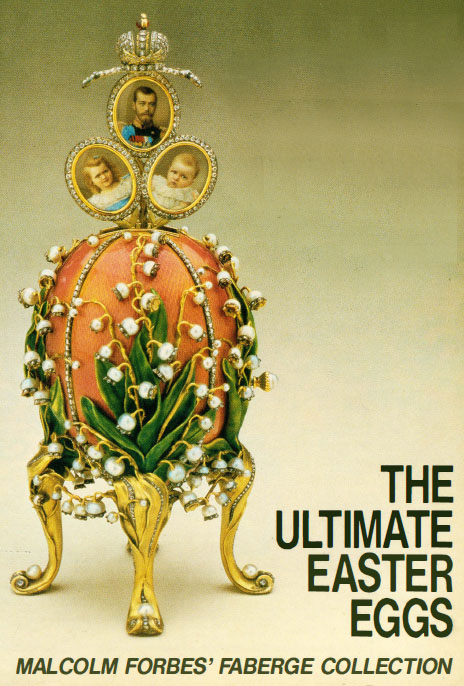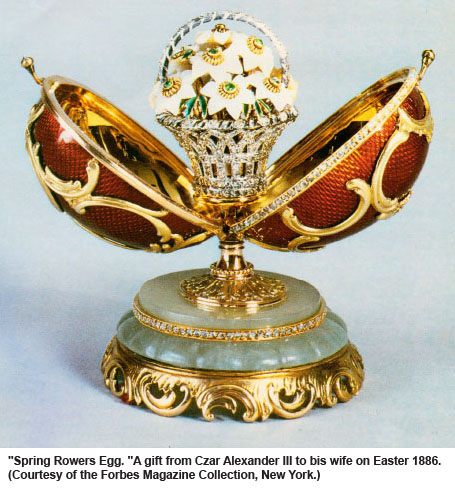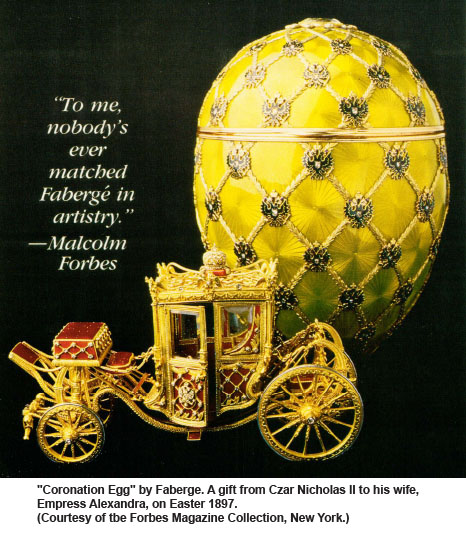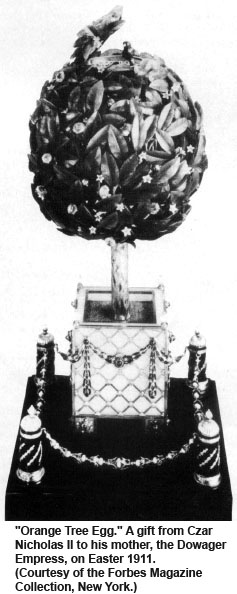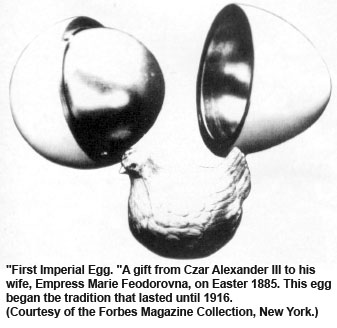quote:
THE ULTIMATE
Easter Eggs
Twelve Exquisite Easter Eggs by Faberge:
The Pride of the Malcolm Forbes Collection
By Michael Forrest
The egg has been a symbol of creation and of life itself since the earliest civilizations. In the Christian era, the egg came to symbolize the resurrection of Christ, and so began the Russian custom of celebrating Easter and the beginning d spring with the exchange of three kisses and the gift of an egg. Never was this tradition more lavishly observed than by the Russian Imperial family at the turn of the century. In 1884, Czar Alexander III commissioned the first Imperial Easter egg from the court
jeweler, Carl Faberge. It was to be a present for the Czar's wife, Marie Feodorovna. The egg was to be both precious and very unusual; expense, time and labor would be of no consequence. But the Czar had one stipulation. He wanted to have the final say on its design and formation. Faberge, on the other hand, felt that, in order for the gift to be totally enjoyed, it should come as a complete surprise to everyone, including the Czar. Reluctantly, the Czar consented.One can imagine, therefore, the Czar's concern almost a year later, on the eve of Easter, when he was presented with a rather plain, white enameled egg. This was his first surprise.
The two halves of the egg were held together by a bayonet fitting, and, when they were opened, a yellow-gold yolk with a dull, sandblasted surface was revealed-another surprise and even less attractive than the egg itself. But, of course, inside the yolk, which was opened in the same manner as the shell, sat a yellow and white tinted gold hen. Not only was the hen another surprise, but it was truly a miniature work of art. Each feather was most beautifully engraved, two cabochon ruby eyes were set in its head, and its beak and comb were carried out in red gold. But this was not all, for by lifting its head, the hen opened on a hinge at its tail, and inside was found an exact diamond replica of the Imperial crown; when, in turn, the crown was opened, a tiny, perfectly formed ruby hung on a silver pendant.
This egg was the first of fifty-six celebrated Easter eggs that Faberge would create for the last two Russian Czars, Alexander III and Nicholas II, and the ornate hen and crown were his first true miniatures. Today this egg is in the collection of Malcolm Forbes, who maintains homes in Montana, Colorado, New Jersey and New York.
Through the years, the Imperial Easter eggs contained other miniatures, each more exotic and more complicated. In 1889, for example, there was the "Resurrection Egg." It is one of the few Imperial eggs with a religious motif. Inside the clear rock-crystal oval, which is studded with diamonds and pearls, the figure of Christ stands atop a green tomb flanked by two kneeling angels. This egg was acquired by Forbes in 1978. In another egg is found an exquisite assortment of spring flowers carved in milky chalcedony with olivine centers; their leaves are enameled in translucent green gold. This bouquet is set in a platinum basket with a handle of rose diamonds. This is the "Spring F lowers Egg" and was purchased by Forbes in 1966.
The "Lilies Of The Valley Egg" which Czar Nicholas II gave to his mother, the Dowager Empress Marie Feodorovna, on Easter 1898, is almost Art Nouveau in style. Here a bouquet of pearl-and-diamond lilies cling to a delicate pink enamel oval. The surprise inside, which emerges from the top when a pearl button is turned, is a trio of jeweled frames with miniature portraits of Czar Nicholas and his two daughters, Grand Duchesses Olga and Tatiana. Forbes has had this egg since 1979.
Many of the Imperial eggs contained automated animals. There were prancing elephants, lumbering rhinoceroses and hippopotamuses, a variety of twittering birds and, perhaps the most elaborate, a four-and-three-quarter-inch peacock perched on a tree of gold with flowers done in precious stones. When lifted from its tree and wound up, it struts proudly about, placing one foot carefully before the other, moving its head and, at intervals, spreading and closing its varicolored enamel tail. Fortunately, the processes involved in creating this peacock have been recorded.
After several designs were submitted to Faberge for review, a wax and then a plaster cast were produced, which were almost as large as the real peacock. Successive models were in turn made, each somewhat smaller in order to be quite certain of the complicated mechanism on such a small scale. Almost one hundred craftsmen
and women-designers, lapidaries, chasers, setters, engravers, gilders and enamelers-labored for a full year to create this mechanical "toy" and, as with all of Faberge's automatons, its purpose was not merely to astound the beholders but rather-and this was much more difficult to attain-to completely charm and divert them.Unfortunately, the "Peacock Egg" is not in the Forbes collection. It is one of the ten eggs now in the Kremlin. But another mechanical bird can be found in the "Orange Tree Egg," which is in the Forbes collection. This egg is a topiary-like creation that Czar Nicholas II gave to his mother, the Dowager Empress, on Easter 1911. The whimsical gold-and-nephrite orange tree is studded with jewels. When the correct orange is turned, a mechanical bird emerges, chirping, from the top.
Perhaps the most fascinating and certainly the most elaborate egg of all is the "Coronation Egg," which Forbes acquired in 1979. This egg was a gift from Czar Nicholas II to his wife, Empress Alexandra, on Easter 1897. It is just five inches long. Its gold enamel finish has trellises of gold and is adorned by
double headed Imperial eagles in black enamel. The egg opens to reveal a gold-and-raspberry-red enameled working miniature of Czarina Alexandra's coronation coach.At sixty-eight, Malcolm Forbes is something of a phenomenon. Publisher and editor-in-chief of Forbes, the influential business magazine founded by and named after his father, he is probably better known for how he spends and enjoys his money than how he makes it. In addition to Easter eggs, he also collects pictures, sculpture, furniture, books, autographs and important documents, especially important Presidential documents. He has, for example, a copy of the Emancipation Proclamation signed by Lincoln, his personal secretary and the Secretary of State; and the letter from Einstein to Roosevelt, in which the physicist gave the green light for the atomic bomb.
Forbes also loves toys. He has the world's largest collection of toy soldiers, seventy thousand, which are carefully displayed in dioramas of historic battlefields in "Mendomb," his castle in Tangier, Morocco.
But it is his eggs, which he displays in his small museum at the Forbes Magazine Building (60 Fifth Avenue, New York City), which are his pride and joy. "These are works of great art," he explains. "To me, nobody's ever matched Faberge in artistry. The Russians got red of his work as typical of Romanoff excesses, and I'm glad they did."
Forbes bought his eleventh egg, the "Cuckoo Egg," in 1985 for a record $1.76 million. Just this last May Forbes purchased the "Rosebud Egg," a gift to the Czarina in 1895. This egg, originally acquired in Russia just after the Revolution by an English dealer, was lost for several years. But Forbes's art-finding sleuths managed to locate it, still in England. The strawberry enamel egg is in poor shape; it had apparently been dropped (or thrown) sometime during its turbulent history. The price Forbes had to pay for this discovery and purchase has not been disclosed. "Eggs," he reminds us with a wry grin, "usually come by the dozen, but they're not necessarily cheaper that way!"










